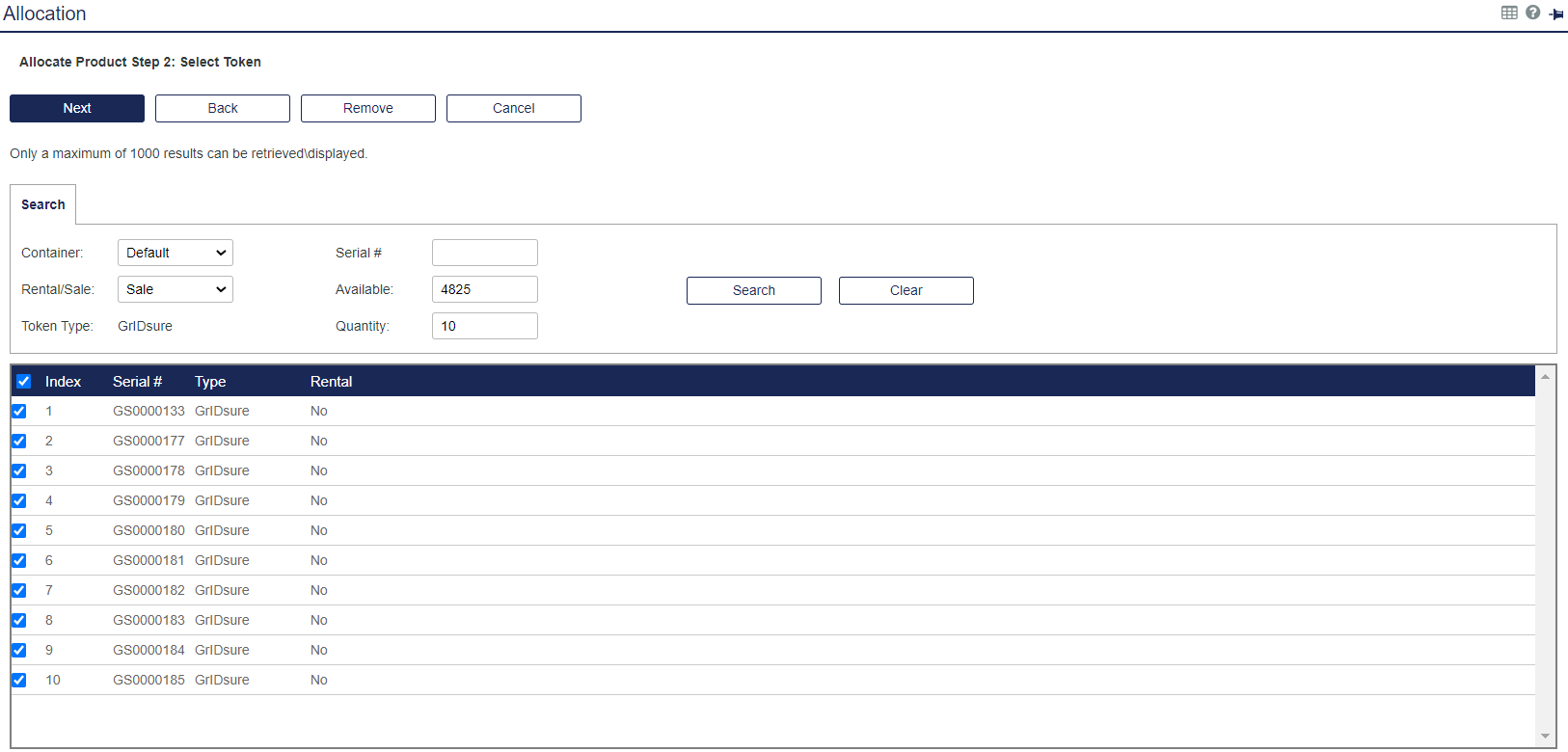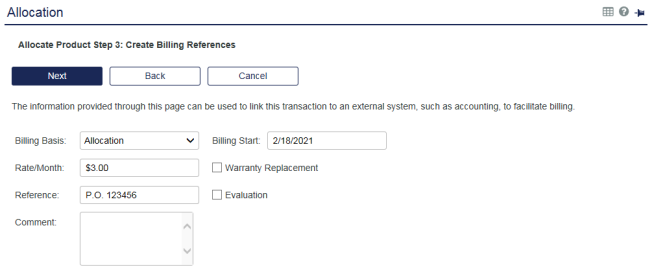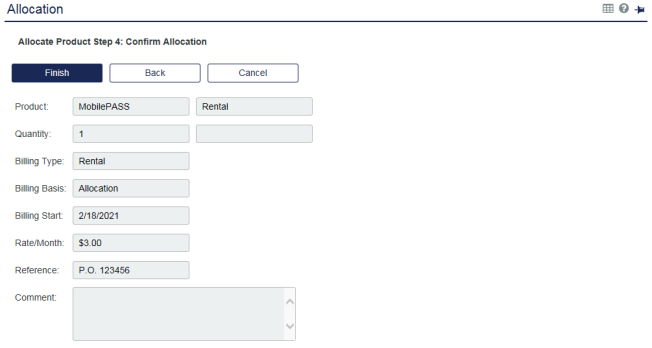Token allocations
Allocation enables you to allocate tokens and capacity to the account. The allocation process moves inventory into the account’s Virtual Server. To view a summary of your inventory that is available for allocation to an account, go to the Inventory module on the Dashboard.
You can also deallocate some or all of the inventory allocated to an account.
On the SAS console, the On-Boarding > Allocation module shows the capacity and quantity of all token and authentication types that are allocated to an account’s Virtual Server.

-
Maximum: Shows the total, by capacity and authentication method, allocated to the account.
-
In Use: Shows the capacity and authentication methods that are consumed by the account. For Virtual Service Providers, it shows the capacity and authentication methods that are consumed for their own use or allocated to accounts that they manage.
-
Available: Shows unconsumed capacity and authentication methods.
Allocate a token type or capacity
You allocate each type of token and capacity to an account in a separate transaction.
The steps in the allocation process depend on the type of allocation. In general, allocation includes the following steps:
-
Step 1 - Determine the allocation type: Select either rental, sales, capacity, or SMS Credits.
-
Step 2 - Select tokens: Indicate the quantity of inventory to allocate.
-
Step 3 - Create billing references: Specify the amount to charge for the transaction or unit of transaction, billing triggers, customer reference, and comments.
-
Step 4 - Confirm allocation: Verify the details such as Product, Quantity, Billing Type and others, before finishing the process.
Step 1: Determine the allocation type
-
In the On-Boarding tab and select the account.
-
Select the Allocation module.

-
Click the Allocate button.

-
Select one of the following allocation types and any corresponding options:
- Capacity Only: Indicates that tokens are not included in this allocation. This option allows you to bill for the service without billing for tokens. Typically, use this option to allow an account to use tokens they already own and will import or initialize in their Virtual Server. For example, select this option if you are migrating an account from an in-house system with tokens that are compatible with SAS.
-
Tokens:
-
Transaction Type:
Sale: Indicates that token ownership is transferred to the account. Inventory that is not owned cannot be allocated in a sale transaction. Use this option for accounts where the user wants to own the tokens, rather than have the cost bundled into their recurring cost per user.
Only inventory that is available for sale can be used in a sale transaction.
Tokens can be allocated without capacity. Choose this option if replacing lost or damaged tokens owned or rented by the account.
Tokens can be allocated with a corresponding quantity of rental capacity. This option is the equivalent of two separate transactions: Rental > Capacity Only and Sale > Token (without capacity).
Rental: Indicates that ownership does not transfer. This transaction type can allocate from a token inventory that contains sale and rental tokens. Use this option for accounts that pay a recurring fee per user for capacity or some combination of capacity and tokens.
-
Token Type: Indicates the type of token to allocate.
-
Automatically add capacity with this allocation: Allocates a corresponding quantity of capacity.
If the Transaction Type is Sale, this option adds an equal amount of additional capacity to support the purchased tokens. Do not select this option if the account does not require additional capacity. For example, select this option for an account that is replacing owned tokens that have been lost, or replacing one token type with another.
If the Transaction Type is Rental, select this option if the account will pay a fee per user for the service, including a token per user.
-
-
SMS Credits: Transfers a quantity of SMS credits to the account.
To allocate SMS credits, go to Allocate SMS credits.
-
Select Next.
Step 2: Select tokens
The next step is to select the tokens to allocate. The list of available tokens varies depending on how your inventory is managed.

-
Enter the search criteria. At a minimum, enter the Quantity to allocate. You can use any of the following options in your search:
-
Container: Indicates the container to allocate token inventory from. The Default container holds all tokens, unless additional containers have been created and inventory has been added to them.
-
Rental/Sale: Limits the tokens that are displayed in the list to Rental or Sale. Sale tokens can be allocated as sale or rental, while Rental tokens can be allocated only as rental.
-
Serial #: (Hardware tokens only) Selects a specific token from inventory, by serial number.
-
Available: Indicates the quantity available for allocation.
-
Quantity: Indicates the quantity to list.
-
-
Click Search.
The list is populated with inventory that matches the search criteria.
-
Select the check boxes for the tokens that you want to allocate.
-
Click Next to proceed to the next step.
Or, click Remove to remove the selected inventory from the Allocated list.
Step 3: Create billing references
Billing references are used in reporting to indicate how the transaction should be billed, and to link the transaction to customer references, such as purchase order numbers.

-
Billing Basis: The reporting system uses this flag to indicate the billing method associated with the transaction. It includes the following options:
-
Allocation: Indicates that billing occurs on the date when the inventory is allocated to the account.
-
Activate: Indicates that billing occurs when the token is assigned to a user. The user can be a user of this account or any account that it transfers the token to.
-
Authentication: Indicates that billing is based on token usage, where each authentication incurs a charge.
-
Transfer: Indicates that billing should start when this account (Virtual Service Provider) allocates inventory to an account that it creates and manages. Transfer provides a mechanism to bill for the entire transaction or for only the quantity that is transferred.
-
-
Billing Start: Modifies the Billing Basis to indicate a date other than the transaction date to start billing. This is useful for allowing a grace period before billing commences. For example, on allocation, the Billing Start could allow 30 days after allocation before billing starts, whereas on Transfer, the Billing Start date could start billing on this date regardless of whether the inventory has been transferred.
-
Rate/Month: Indicates the charge that is applied per unit that is transferred. Do not include a character that is not easily used within the external billing system (for example, $, £).
-
Warranty Replacement: Indicates that the allocation is to replace product under warranty. When producing billing reports, this information helps to distinguish between new orders, billable product, and no-charge warranty replacements.
-
Reference: References external information that is related to this allocation, such as the customer purchase order number or a sales order number. This allows the transaction to be linked to external processes, such as order fulfillment.
For a Warranty Replacement, use the Reference to record the Return Material Authorization (RMA) number with the warranty replacement.
-
Evaluation: Indicates that the allocation is provided for evaluation purposes.
-
Comment: Include optional comments related to the transaction. Comments form a permanent part of the transaction record.
Step 4: Confirm allocation
This final step provides the opportunity to verify before committing the entire transaction.

The allocation table is updated when you select Finish.
View the allocation transaction log
A transaction record is created for each allocation.
-
Click the Transaction Log button in the Allocation module.

The transaction log lists the following information:
-
Transaction ID - This is a unique number assigned by the server to each allocation by the service provider. The transaction ID is a hyperlink if the transaction includes tokens. Clicking the hyperlink displays a list of all tokens by serial number included in the transaction.
-
Reference - This is a value entered by the service provider when allocating the token, generally to aid in identifying the transaction when communicating with the account. This value may have meaning only to the service provider.
-
Allocate to - This is the account which received the inventory allocation. For example, when a service provider allocates inventory, the value in this field will be the name of the account that received the inventory. Conversely, during deallocation inventory is returned to the service provider and therefore the service provider name will appear in this field.
-
Allocated From - This is the account that allocated the inventory. The values in this field are the opposite of Allocate to.
-
Date - This is the date and time of the allocation.
-
Quantity - This indicates the item quantity of the transaction, usually tokens or SMS credits.
-
Product - This indicates the primary item in the transaction. If the transaction contains tokens, this will display the token family such as KT, RB etc. A transaction cannot contain more than one token type.
-
Type - This indicates Rental or Sale. Rental indicates that the allocation of tokens or authentication methods is part of a subscription, incurring a periodic charge for usage. Sale indicates that tokens or authentication methods have been purchased.
-
Capacity - This indicates the quantity of capacity included in the transaction. Note that capacity is always a rental transaction even when included in a transaction with tokens marked as Sale.
-
Changed by - This is the name of the Account Manager that performed the allocation.
Every allocation has a unique transaction ID. The transaction ID is a hyperlink if the allocation includes tokens.
-
-
Click the hyperlink to display a list of all tokens that are included in the transaction by serial number.
A duplicate of the allocation table and transaction log is available on the Snapshot tab of the account’s Virtual Server.

